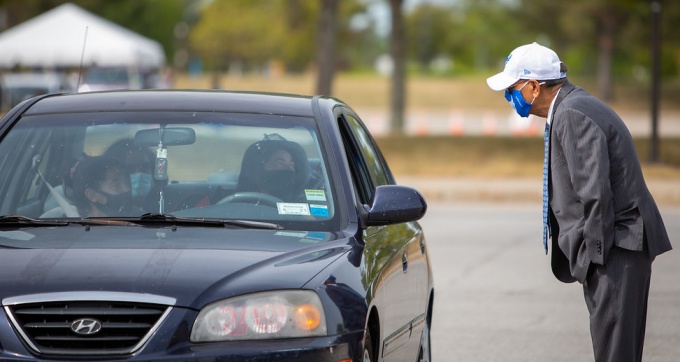UB's Resiliency Prevails

President Tripathi greets families and students during the check-in process in late August 2020.
“A university is not a group of buildings. It is a group of persons assembled for the purpose of passing on the knowledge and the standards of conduct … and for the creation of new knowledge and improved standards. This is a truism, but it is so often forgotten that it needs constant reiteration. If the group could meet and accomplish its purpose in an open lot, a university would be there.”
When Samuel Capen, the University at Buffalo’s seventh chancellor, wrote those words in 1923, he could not have envisaged that, nearly a century later, our UB community would be “accomplishing its purpose”—at least in part—via Zoom.
And yet, as we have embarked on a fall semester unlike any in our university’s 175-year history, his comment aligns precisely with the present moment.
It reminds us that our students, faculty and staff constitute the heart of UB. Whether we assemble side by side, with six feet of space between us, or from separate locations by videoconference, UB has always been defined by our scholarly community’s intellect, innovations and contributions to the greater good.
Of course, it frustrates us that the pandemic has prevented us from taking full advantage of UB's classrooms, research labs, studios—indeed, the whole of our living-learning environment. Like universities across New York State and the nation, advancing the ideals of higher education amid a public health crisis has proved trying on every front.
That is precisely why, throughout this extraordinary chapter in our shared history, I have been so impressed with, and inspired by, our university’s uncommon resiliency and commitment in the pursuit of our academic, scholarly and professional endeavors.
In March, when Governor Andrew Cuomo mandated that SUNY transition to a remote-learning environment, UB faculty and staff worked swiftly and tirelessly to ensure that our students continued to receive a transformative educational experience. The result? Within 10 days, approximately 4,000 courses—more than 99 percent of our classes and the vast majority of our labs—had been adapted to this model.
At the same time, faculty across the disciplines were bringing their expertise to bear on the burgeoning COVID-19 crisis. These efforts included everything from serving on the front line of care to leading a clinical trial on a potential treatment, from using 3-D technology to develop safe, effective N95-like respirators to addressing the disparate impact of the disease on underserved minority populations.
Whether faculty, student, staff or alumni, this is how we identify as a university community—by the positive impact we make on the world. That has been the case since our university’s founding. Whether in times of peace and prosperity, or times of uncertainty and turbulence, we never fail to uphold UB’s mission and vision of excellence.